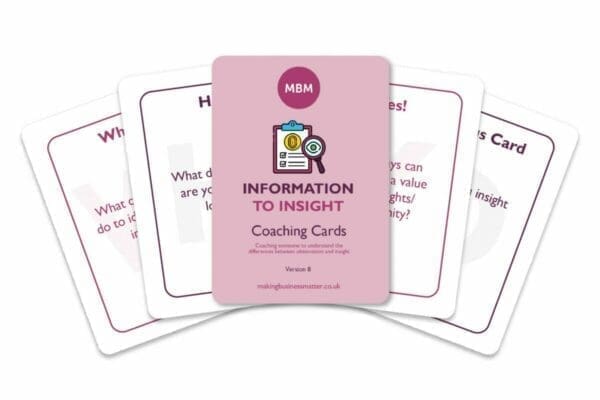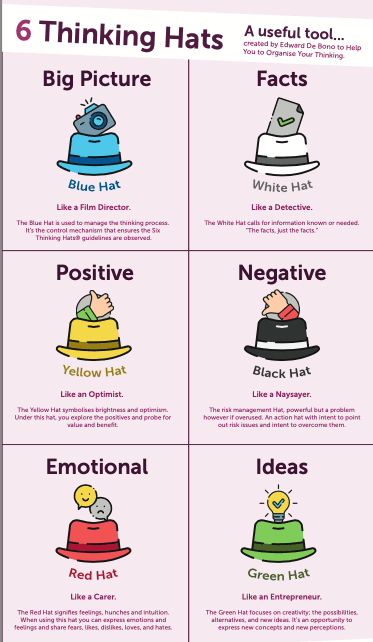The Six Thinking Hats is a Tool to Help You to Organise Your Thinking.
It helps to improve productivity by encouraging you to wear a different ‘hat’. Each of De Bono’s thinking hats has a colour and a role. The 6 thinking hats are; logic, emotion, caution, optimism, creativity, and control. By wearing each hat the person, or the team, ensures that they are considering the problem, project, or situation from each perspective. The coloured hats are used as metaphors for each direction – a mindset. The most famous of the 6 hats is the black hat. When worn it asks us to look at the situation from the perspective of risks, difficulties, and problems.
This is not to be confused with the 5 thinking hat model or the 5 hats idea, which is a Coping Mechanism for use with managing mental health. This article discusses the 6 thinking hats or the six hats.
If You Never Change Your Mind, Why Have One? – Edward De Bono
The associated idea of parallel thinking provides a means for groups to plan thinking processes in a detailed and cohesive way, and in doing so to think together more effectively.
Edward De Bono was born in Malta in 1933, has a PhD in medicine and psychology and has written over 62 ‘thinking’ books. He is the father of original ideas like lateral thinking, parallel thinking, Direct Attention Thinking Tools (DATT), and much more.

Read our return policy.
>> Information to Insights Coaching Cards <<
What are the 6 Thinking Hats? And What are the Six Colours of the Thinking Hats?
This will help you understand ‘thinking hat meaning’:
- Blue Hat thinking is the big picture, like a Film Director.
- The Blue Hat is used to manage the thinking process. It’s the control mechanism that ensures the Six Thinking Hats® guidelines are observed.
- White Hat thinking is facts, like a Detective.
- The White Hat calls for information known or needed. “The facts, just the facts.”
- Yellow Hat thinking is positive, like an Optimist.
- The Yellow Hat symbolizes brightness and optimism. Under this hat, you explore the positives and probe for value and benefit.
- Black Hat thinking is negative, like a Naysayer.
- Risks, difficulties, Problems – The risk management Hat, probably the most powerful Hat; a problem however if overused; spot difficulties where things might go wrong, why something may not work, inherently an action hat with the intent to point out issues of risk with intent to overcome them.
- Red Hat thinking is emotional, like a Carer.
- The Red Hat signifies feelings, hunches and intuition. When using this hat you can express emotions and feelings and share fears, likes, dislikes, loves, and hates.
- Green Hat thinking is ideas, like an Entrepreneur.
- The Green Hat focuses on creativity; the possibilities, alternatives, and new ideas. It’s an opportunity to express new concepts and new perceptions.

Click on the image below to view our full size 6 Thinking Hats infographic:

Hear About the Hats from the Man Himself – Edward De Bono
Click on the image below to view the video:

What are the Advantages of Using the 6 Thinking Hats?
By using the 6 thinking hats you can organise your/your team’s thinking by providing a structured approach. Plus, by doing so, you will have considered the situation from all angles. The 6 thinking hats are a problem-solving tool. on that stimulates people, helps them to evaluate things from new perspectives, and reduce conflict among a team by enabling everyone’s thoughts to be heard. In essence, provides means for groups to plan thinking processes in a detailed & cohesive way, and in doing so to think together more effectively. Whilst enabling groups to do thinking ahead.
What do the De Bono Six Thinking Hats Mean?
The six thinking hats were first published in 1985 by the respected psychologist Dr Edward de Bono. The inspiration for writing the book came from structuring creative thinking, which often leads to confusion and disagreement, especially in groups of people. The thinking hats enable groups to have organised and effective group thinking.
How do You Use the Six Thinking Hats?
Multiple Applications for the 6 Hats
The hats can be used for many different situations. For example:
- To explore a project before it begins.
- As a structure for a meeting.
- To improve decision-making for a team.
- For solving a particular problem.
- To generate new ideas and solutions.
Using Hat Sequences
The 6 thinking hats can be used in any order and can be used multiple times in one session – re-visiting an already used hat. The hats of thinking can also be used in sequences to be as effective as possible. Plus, you also don’t have to use all of the hats. Sometimes you might just need 3 hats to work through a problem. Knowing which hats to use and not use can be complicated, so if in doubt, use all the hats. Alternatively, here are some examples of how you can specifically use the hats in sequences:

- Initial ideas, and brainstorming:
- Blue+ White+ Green+ Blue.
- Identifying solutions:
- Blue+ White+ Black+ Green+ Blue.
- Strategic planning:
- Blue+ Yellow+ Black+ White+ Blue+ Green+ Blue.
- Problem-solving:
- Blue+ White+ Green+ Red+ Yellow+ Black+ Green+ Blue.
- Comparing fact and opinion:
- Blue+ White+ Red+ Blue.
- Comparing and synthesising (coming up with new ideas from the known):
- Blue+ White+ Yellow+ Black+ Green+ Blue.
- Choosing between alternatives:
- Blue+ White+ Yellow+ Black+ (Green)+ Red+ Blue
- Quick Feedback:
- Blue+ Yellow+ Black+ Green+ Blue.
- Process Improvement:
- Blue+ White+ White (Other peoples views)+ Yellow+ Black+ Green +Red +Blue.
- Performance Review:
- Blue+ Red+ White+ Yellow+ Black+ Green+ Red+ Blue.
Guidance for Using De Bono’s Thinking Hats
Use the blue hat at the beginning and end because the Blue hat is worn by the facilitator. The facilitator can evolve the sequence as is needed to achieve the objective, i.e. re-visiting the hat, even though it was not in the original plan.
You can use any hat, as often as needed and you do not need to use every hat. Hats can be used singly at any point or as a sequence of two, three, four or more hats, and the time spent on each hat is short – only a few minutes. Particularly for the red hat, where instinct is key. The key to effectively using the hats is focus and discipline. It is easy for the individual, or group, to stray to another that. The facilitator must ensure that this does not happen.
What are the Different Roles of De Bono’s Thinking Hats?
What is Blue Hat Thinking? The ‘Managerial Hat’: To Take an Idea from Conception to Implementation.

The Blue Hat thinking is the big picture. It is used to manage the thinking process. It’s the control mechanism that ensures the Six Thinking Hats® guidelines are observed. You wear this hat to ensure that the hats thinking process is working effectively. We might liken this hat to that of a project manager. You will always start and end with the blue hat.
Examples of Blue Hat Questions:
- Which problem or situation are we wanting to solve?
- What is the outcome we want?
- What are the benefits of solving this problem?
- Which sequence shall we use for the hats?
- How will we get the best out of the time we have?
- What is the most effective method of proceeding?
- Have we got the right people in the room?
Examples of Things a Blue Hat Would Say:
- The agenda for our 6 thinking hats on project XYZ looks like…
- This sequence of hats is the best to achieve our objectives.
- Our goal is to achieve a turnaround in the shopper situation from 1% to 5%.
- The benefits of solving this problem are the following…
- Let’s evaluate where we are so far.
- We’ll go back to the red hat because that needs further exploration.
- Evaluating our work today, we need to look at it this way together.
Blue Hat Objectives
- Ask questions that manage the process better and direct the thinking.
- Organising ideas into action plans.
- Designing the agenda, rules, goals, and tasks for problem-solving.
What is White Hat Thinking? The ‘Neutral Hat: To Carefully Explore the Facts of a Problem in an Objective Way.

The White Hat thinking is facts. It calls for information known or needed. Wearing this hat we focus on the information. The facts. We have to be careful when wearing each hat to focus on the requirements of it. Being careful not to ‘trespass’ into other hats. The opposite hat might be the red hat of emotions and feelings. A ‘closer’ hat would be that of the green hat, where we might be tempted to generate ideas for the information problems we uncover.
Examples of White Hat Questions:
- What facts are available to us now?
- What data is missing?
- In order to achieve the project/problem objectives, what facts do we need?
- What facts are we using that might be assumptions?
- Which data might be classed as unreliable?
- Who has the data that we need?
- If there is no data can we proceed?
Examples of Things a White Hat Would Say:
- The project provides no weekly update on what is happening.
- We are 7 weeks behind the first milestone.
- There is no data available for the fourth quarter.
- We need data to support the shopper’s choices of the product range.
- Sales are ahead by 7.1%.
- We are using 3 assumptions about constructing this building that we need to consider more carefully.
- There is too much data to analyse.
White Hat Objectives
- Prioritising facts over opinions and beliefs.
- Identifying gaps in knowledge.
- Bringing forward facts, and data that can be used to solve the problem.
What is the Red Hat Thinking? ‘The Intuitive Hat: To Think Instinctively and Explore Feelings and Hunches.

Red Hat thinking is emotional. It signifies feelings, hunches and intuition. When using this hat you can express emotions and feelings and share fears, likes, dislikes, loves, and hates. Yours, or others. Gut instinct is important with this hat.
Getting to the ‘heart’ of the problem is essential here. Often emotions are side-lined in professional meetings. They should not be as people come to work because they want to make a difference. Not just to collect a paycheque. Of course, that is important. It is not the only reason. This ha5 allows us to be ourselves.
Examples of Red Hat Questions:
- What are my feelings about this?
- How do others feel about this?
- My instincts – what are they telling me?
- What’s my hunch about this?
- How passionate are we about making this happen?
- What 3 emotions does this situation make me feel?
- Why am I <emotion> about this?
Examples of Things a Red Hat Would Say:
- This project is really frustrating to me.
- Our customers love this product because…
- I’m angry when we have meetings about this that achieve nothing.
- My emotion towards the sales department is <emotion>.
- I’d love to feel more passionate about this.
- We never have enough time to get this done properly.
- Others have said that they feel annoyed by this.
Red Hat Objectives
- Finding out how others feel, and what their hunches are.
- Exploring the emotional perspectives.
- Uncovering hidden internal conflicts.
What is the Yellow Hat Thinking? ‘The Optimistic Hat’: To Explore Opportunities to Make the Most of Explored Ideas.

Yellow Hat thinking is positive. The opposite of the Black Hat. It symbolises brightness and optimism. Under this hat, you explore the positives and probe for value and benefit. Yellow hats are optimists. Quick to see the benefits. They believe that ‘If there’s a will, there’s a way’ and ‘every idea is a good idea’.
Examples of Yellow Hat Questions:
- How can we achieve our end in mind?
- What does success look like?
- If we could not fail, what would we do?
- What are the short term, medium-term, and long term benefits?
- How would we feel when this is achieved?
- What is the best way to approach this issue?
- Name 3 positives.
Examples of Things a Yellow Hat Would Say:
- This project can absolutely achieve our objectives if we do XYZ.
- We could do x to achieve the more ambitious targets.
- When we nail this problem let’s all go out and celebrate.
- To celebrate the achievement let’s share the success in a case study.
- Let’s generate 10 more ways to solve this so that we have a backup plan.
- The stretch target would be ABC.
- By solving this problem we will also solve these two other problems.
Yellow Hat Objectives
- Identify why an idea, plan, or suggestion, could work.
- Exposing where an idea might succeed.
- Completing a positive risk assessment.
What is the Green Hat Thinking? ‘The Creative Hat’: To Challenge Perspectives and Explore Creative Possibilities.

Green Hat thinking is ideas. It focuses on creativity; the possibilities, alternatives, and new ideas. It’s an opportunity to express new concepts and new perceptions. These hatters think outside the box, looking for solutions that can break the rules and be untypical. To a green hat thinker, there is a problem to every solution.
Examples of Green Hat Questions:
- How can we generate 10 solutions to this problem?
- How would the Virgin company solve this problem?
- What would Steve Jobs do to solve this problem?
- How about if we….?
- What if we looked at this from the perspective of the shopper, the prepare or the eater?
- What brainstorming tools can we use to find solutions?
- How can we use the random word brainstorming technique to solve this?
Examples of Things a Green Hat Would Say:
- The maths brainstorming technique works really well to solve this.
- If we approach this from the shopper’s perspective then they would say…
- In the film ‘World War Z’ the technique they used was the ’10th man principle’ – let’s do that.
- I’ve asked another team to join us because they are not so close to this problem, to see what they think we should do.
- Let’s generate 10 ideas in 3 minutes and then pick the best.
- Let’s create a suggestion box for the company to solve this and other problems.
- If I had a magic wand I’d…
Green Hat Objectives
- Offering creative ideas and solutions.
- Expanding the thinking of ideas and solutions.
- Bending the rules.
What is Black Hat Thinking? ‘The Pessimistic Hat’: To Identify the Risks and Problems From Every Perspective.

Black Hat thinking is negative. Risks, difficulties, Problems – The risk management Hat, probably the most powerful Hat; a problem however if overused; spot difficulties where things might go wrong, why something may not work, inherently an action hat with the intent to point out issues of risk with intent to overcome them. These thinkers are cautious and find the problem in every solution.
Examples of Black Hat Questions:
- How will this fail?
- Will this work, really?
- Why won’t this work?
- What if no one buys it?
- How will the competition react?
- What speed bumps are most likely?
- What stakeholder will trip this up?
Examples of Things a Black Hat Would Say:
- This will go wrong because we haven’t considered XYZ.
- We have not identified the risks.
- On a scale of 1-10, I think we have a 2/10 chance of this working.
- We have not considered the department of ABC.
- The customer research said that they didn’t like XYZ.
- If we walk forward two years the reason it will be less successful is because of XYZ.
- Our track record of success in this area suggests that we need to be mindful of the input from the x people.
Black Hat Objectives
- Seeing the flaws in a plan.
- Identifying the risks.
- Exposing where the solutions won’t work and why.
An Example of Using the 6 Thinking Hats
A category is not performing. Sales are decreasing and the category team need a way to review the performance that is not the usual approach because, as the saying goes, ‘The definition of madness is to do the same thing and expect a different result.’
The 5 members of the category team gather for a meeting using the 6 thinking hats. They start with the blue hat and agree that to achieve their objective of reviewing the category’s performance from all angles they will use all 6 hats and see what they can achieve. They then agree that with their limited knowledge of the hats they’ll use them all and in the order of; blue, white, green, yellow, red, black, and then back to blue.
Next, whilst still using the blue hat agree that they will spend a maximum of 5-minutes on each hat, and capture the output as separate flipcharts. Someone draws a coloured hat on each flipchart and everyone has a pen. One member of the team is identified as the facilitator and timekeeper to keep the team on track. They also agree that the entire process should take 30-minutes, including a review of the process using the blue hat again.
The team start working through each hat, capturing their output, sharing it with each other, and the facilitator keeps them not rack, focusing their thinking on the correct hat. In the end, the team have a flipchart for each of the white, green, yellow, red, black hats. The facilitator reminds them to return to the blue hat and to evaluate how they did versus their objectives for this session, and what they should do next.
Concluding the 6TH
The Six Thinking Hats is a problem-solving tool. This tool enables us to avoid the conflict that often happens when groups of people are wanting to solve a problem. This is achieved because everyone looks at the problem from the same perspective, rather than in a typical problem-solving situation, for example, there is one person being positive, one negative, and already conflict is occurring. Rather than their energies being put into solving the problem, the energies are used to position themselves, assert authority, and ‘win’.
Whether your objective is to fix a project, solve a situation, find a solution to a problem, or improve your decision making, this problem-solving tool will help you to find solutions, identify new opportunities, and uncover risks that you didn’t know existed. Plus, provide an essential management tool to enable teams to achieve much more and in less time by working together collaboratively, instead of having to also deal with the challenging dynamics of teamwork.

But what are the 7 hats? One way to represent this idea is to stack the six hats together instead of using them separately. This approach ensures that cultural perspectives and values are taken into account, in addition to change drivers, systems, and processes.
Interesting Fact: What is Red Hat and Black Hat?
Here’s a fun fact while we’re on the topic of mindset and ‘hats.’ Red-hat and black-hat hackers pursue divergent objectives. While black hats aim to profit by stealing data or causing system failures, red hats utilize their knowledge and abilities to achieve positive outcomes and teach attackers a lesson.
Related reading: Check out our ultimate guide on HBDI.




